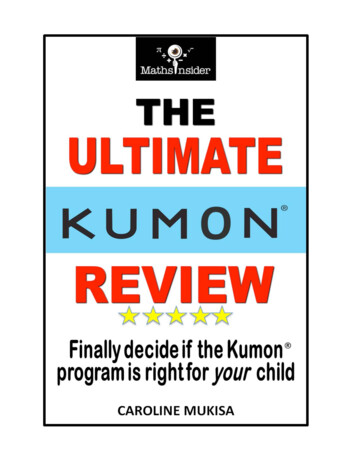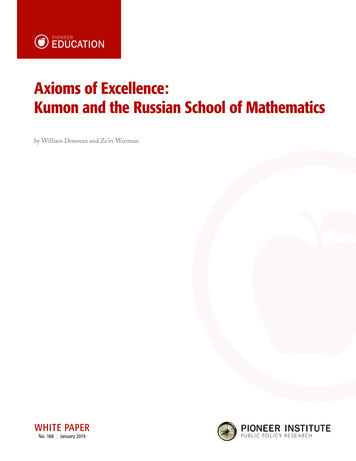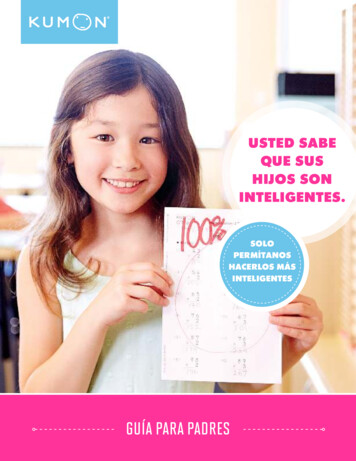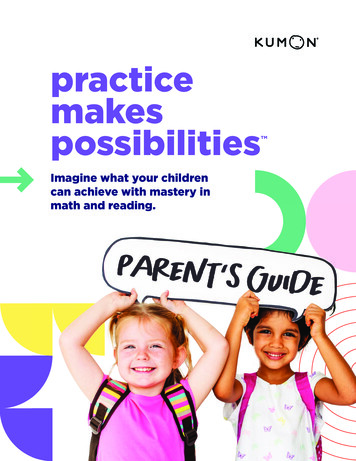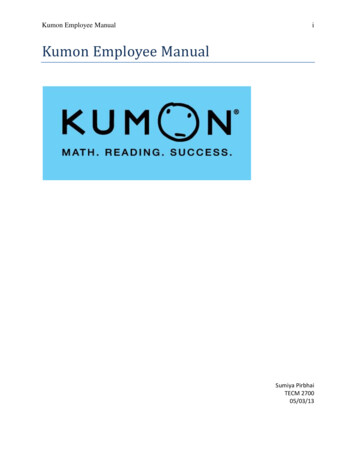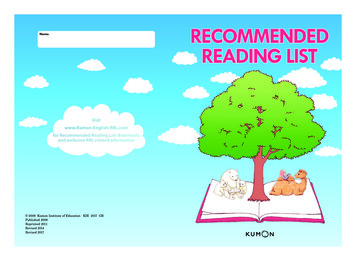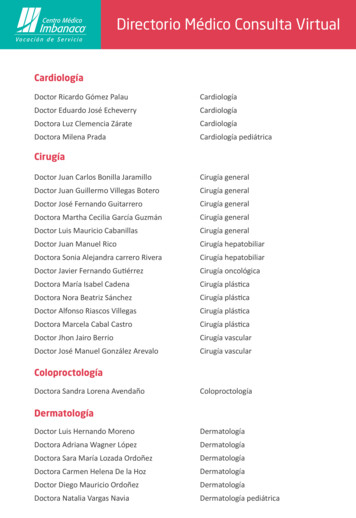
Transcription
TeacherDoctorMusicianBallerina
ContentAbout Kumon. p3The KumonWorksheets. p4The Kumon Instructor. p5Study Flow. p6Maths Programme. p8English Programme. p9Chinese Programme. p10Kumon Aroundthe World. p112ConfidenceDaily StudyHabitStrong AcademicFoundationSelf-LearningSkills
about KumonThe world’s largest after-schoollearning programmeOne father’s love for his son gave birth to theKumon Method of Learning. In 1954, Toru Kumon,a high school maths teacher in Japan, createdhandmade maths worksheets for his son in secondgrade of elementary school to steadily develop hiscalculation skills. As a result, he was able to reachthe level of differential and integral calculus whenhe was just a few months into the sixth grade.After more than half a century, his philosophycontinues to spread globally and now helpsmore than 4 million students develop the abilityto achieve their goals and dreams. Right at thismoment, someone, somewhere around the worldis learning through the Kumon Method of Learning.At Kumon, we believe in the potential of each andevery child. Children can advance irrespective oftheir age or school grade level. Each time a childindependently confronts a challenge they havenever known or experienced before, they undergoa process where their ability development ismaximised with a strong sense of achievement.3
The Kumon WorksheetsSelf-learning is facilitated by the constantly evolving worksheetsKumon worksheets are structured to allow progression in small stepsKumon worksheets are structured to allow progression in small steps,enabling each student to advance smoothly from easy to difficult problemsand ultimately toward studying advanced high school level materials ontheir own.Worksheets are revised through learning from studentsSince the original worksheets were created by Toru Kumonin 1954, information such as students’reactions to the worksheets andfeedback from Instructorshave been continuallytaken into account whenrevising worksheets. Bylearning from studentsand Instructors, theworksheets are continuallyimproved to be more effectivefor self-learning.4
THE KUMON INSTRUCTORThe role of a Kumon Instructor is to bring out thepotential in each individualThe Kumon worksheets are designed to allow studentsto advance through self-learning. Nonetheless, there aretimes when students encounter problems that they don’tunderstand or are unable to solve on their own.At times like these, Kumon Instructors do not spoon-feedstudents with problem-solving methods. Rather, ourInstructors find out how much the students understandbefore giving them hints. Instructors may also show studentsexample problems or previously studied material to help themsolve difficult problems on their own. In doing so, students enjoy a sense ofachievement and are able to master new material independently.Kumon Instructors discover what each student is capable of and bring out thepotential in each and every one of them. Our Instructors focus on each studentindividually, paying careful attention to their academic ability, personality and howthey solve the worksheets. Instructors then provide effective support to ensurelearning at a level that is “just-right” for each individual.Kumon Instructors acknowledge the growth of each student without comparisonto others, while offering praise and encouragement. At the same time,they cooperate closely with parents in monitoring the growth of each student.It is through these dedicated Instructors, who sincerely wish for the growth of theirstudents, that the true benefits of the Kumon Method are achieved.5
Study FlowBelow is a typical study flow for Kumon students.Depending on the Centre, there may be variations to the study flow:1 Receiveclasswork- On arrival,your childwill submitcompletedhomework andreceive materials tocomplete at the Centre.63 Submit classwork- Your child willsubmit completedworksheets formarking.2 Study in class- At the Centre, your child willcomplete the assigned worksheets.- The duration for classwork dependson the contents of the worksheetsassigned for the day.- During the initial stages oflearning in Kumon, your childwill typically take 30 minutesfor each subject.
Mathsresults5 Recordof study- Completion timesand scores foreach worksheet willbe recorded.- Should your child study more thanone subject, the same routinefrom steps 1 to 5 will be applied.mistakes and4 Correctget 100 marks- Your child will correct his orher mistakes if thereare any, which willthen be marked.- This allowsyour child toget 100 marksfor everyworksheetcompleted.EnglishChinese7 Do worksheets at home- Your child shouldcomplete theassignedhomework inan environmentthat allows fullconcentration.6 Bring worksheets home- To maximise learningand develop goodstudy habits,worksheets areassigned ashomework fornon-Centre days.7
Maths ProgrammeDevelop ability to self-learn senior high school mathsMaths is a subject that requires an accumulation ofknowledge through practice. With the aim of studyingsenior high school maths (differential and integralcalculus) with ease, students enhance their calculationskills, cultivate their mathematical analysis and developlogical thinking abilities. This leads them to developthe ability to solve various problems that they will facein the future.NMThe Maths Programme consists of 20 Levels,from Level 6A through to Level O, and 5elective courses. The worksheets focus onthe development of strong calculation skillswhich enables students to apply to othermathematical concepts. By avoiding allunrelated concepts, theprogramme aims to allowstudents to advance asquickly as possible ontheir own to differentialand integral calculus.JI8FDCBA2A3A4A5A6ALoci, Sequences and Series,Limits of Functions, DifferentiationTrigonometry, Straight Lines, CirclesK Functions—Quadratic, Fractional,Irrational, ExponentialGEAdvanced Differentiation andIntegration, Differential EquationsLogarithms, CalculusLHFeatures of Maths ProgrammeOBasic High School AlgebraFactorisation, Square Roots, QuadraticEquations, the Pythagorean TheoremSimultaneous Equations,Inequalities, Functions and GraphsPositive/Negative Numbers,Introduction to AlgebraFour Operations of Fractions, DecimalsFractionsLong Multiplication, Long Division,Introduction to FractionsMultiplication, DivisionVertical Addition and SubtractionHorizontal Addition and SubtractionBasic AdditionWriting Numbers up to 120,Introduction to AdditionWriting Numbers up to 50Reading Numbers up to 50Reading Numbers up to 10
English PROGRAMMEDevelop high-level reading abilityIn the English Programme, we aimto cultivate high-level readingability within all students.Through improving students’reading comprehension skillsto a high level, students acquirethe necessary mind-set to readpassages critically. By focusing ondeveloping reading ability throughexposure to a wide range of books, studentsacquire greater interest in reading which facilitateslearning advanced materials with independenceand confidence.Enhance critical reading ability by writing a commenton a passage from an objective tifying thetopic of eachparagraphEI/EIIDI/DIICI/CIIFeatures of English ProgrammeLearn how to support an opinion using informationfrom a passage through analysing and interpretingelements of literature.ReadingcriticallyVisualisinga passageBI/BIIComplete a summary by restructuring pieces ofinformation in a paragraph and making the topic the axisof the summary sentence.Summarise one paragraph of a passage independentlywhile being conscious of the context of several paragraphs.Explain the summary process.Comprehend and compose complex sentences.Read a passage while identifying the topic of each ofits paragraphs.Understand the links between sentences and paragraphs,and the links over paragraphs.Interpret a passage through restatement, examples and description.Comprehend and compose simple sentences.Visualise the contents of a passage by viewing it as a sequenceof events, comparing ideas and identifying 5Ws-1H elements within it.AI/The English Programme begins by enrichingImprove oral reading ability and gradually start reading silently.AIIstudents’ vocabulary and developing basic reading2A Read aloud words and sentences by learning sound partsskills. Students move on to learn about sentencewithin words.Learning3Astructure, paragraph building, summarisation andto readImprove letter-writing ability by tracing, copying and writing words.4Acritical reading. They develop their readingand writeRead aloud and understand short passages.5Acomprehension skills through the Kumon Methodof summarisation. This embodies the processRepeat and recite words, phrases and short sentences.6ARepeatingthrough which students read a passage andAssociatespoken words with their written form.and reciting 7Arearrange each sentence in their own minds.9
Chinese 判性阅读的方法。Develop high-level reading abilityIn the Chinese Programme, we aim to批判性Kcultivatehigh-level reading ability �文或自己的阅读Jallstudents.Through improving students’观点。reading comprehension skills to a high �的关系,掌握文章 students acquire the necessary mind-set to read文章脉络 HI/ 的整体脉络。passages critically. By focusing on developingHII与缩写reading ability through exposure to a ��缩写文。GIIrange of books, students acquire greater interestin reading which facilitates learning 段落间的关系,以话 materials independence and 句 。Features of Chinese ProgrammeThe Chinese Programme begins by enrichingstudents’ vocabulary and developing basic readingskills. Students move on to learn aboutsentence structure, paragraphbuilding, and summarisation.They develop their readingcomprehension skills throughthe Kumon Method ofsummarisation. This embodiesthe natural process throughwhich students read a passageand rearrange each sentence intheir own minds.
Kumon Around the worldapSing oreDuring my PSLE mathematics, I did very well and got an A.I found the paper very easy because I did high level mathematicsin Kumon. I feel very proud of studying at such a level becausemany of my friends have not studied to my standard yet.For me, Kumon is a place that can help me now and in the future.Eric Lim, 13 years oldIiandKumon takes away the fear of studying and helps you realisethat, you can do it! As soon as I have found out that I haveactually completed the Kumon Programme, I felt really proudand happy for myself. When my classmates ask me how I canbe so good at maths, I always tell them, go to Kumon!Yuvraj, 12 years oldAustraliaDoing Kumon isn’t an overnight thing. It takes time to getthrough the levels and to complete it in its entirety. This helpsme to understand that there’s no easy path to success if I amto achieve my goals in life. Give Kumon a go, keep strivingtowards the goal of completing the programme because it’sone of the best lessons you can learn.Marita Cheng, 26 years old11
Call/visit your nearest Kumon CentreJoinKumonRegistration Fee:Fix an appointment for Parent Orientation 40Attend a free Diagnostic Test and consultationsession with the Instructor to know how yourchild’s ability will be developed through KumonMonthly Programme Fee: 140 per subjectFor more informationtel: 65 6232 5855http://sg.kumonglobal.com 2018 Kumon Asia & Oceania Pte Ltd. All Rights Reserved.II02.eSG.05.0418
Worksheets are revised through learning from students Since the original worksheets were created by Toru Kumon in 1954, information such as students' reactions to the worksheets and feedback from Instructors have been continually taken into account when revising worksheets. By learning from students and Instructors, the worksheets are continually
